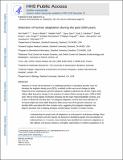Detection of human adaptation during the past 2000 years
Author(s)
Unknown author
DownloadAccepted version (800.2Kb)
Open Access Policy
Open Access Policy
Creative Commons Attribution-Noncommercial-Share Alike
Terms of use
Metadata
Show full item recordAbstract
Detection of recent natural selection is a challenging problem in population genetics. Here we introduce the singleton density score (SDS), a method to infer very recent changes in allele frequencies from contemporary genome sequences. Applied to data from the UK10K Project, SDS reflects allele frequency changes in the ancestors of modern Britons during the past ~2000 to 3000 years. We see strong signals of selection at lactase and the major histocompatibility complex, and in favor of blond hair and blue eyes. For polygenic adaptation, we find that recent selection for increased height has driven allele frequency shifts across most of the genome. Moreover, we identify shifts associated with other complex traits, suggesting that polygenic adaptation has played a pervasive role in shaping genotypic and phenotypic variation in modern humans. ©2016
Date issued
2016-11Journal
Science
Publisher
American Association for the Advancement of Science (AAAS)
Citation
Field, Yair, et al., "Detection of human adaptation during the past 2000 years." Science 354, 6313 (November 2016): 760-64 doi 10.1126/SCIENCE.AAG0776 ©2016 Author(s)
Version: Author's final manuscript
ISSN
1095-9203